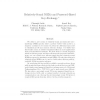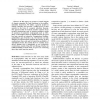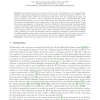PKC
2012
Springer
12 years 9 months ago
2012
Springer
We define a new notion of relatively-sound non-interactive zeroknowledge (NIZK) proofs, where a private verifier with access to a trapdoor continues to be sound even when the Ad...
CVPR
2012
IEEE
12 years 9 months ago
2012
IEEE
Recent years have witnessed the growing popularity of hashing in large-scale vision problems. It has been shown that the hashing quality could be boosted by leveraging supervised ...
CSFW
2012
IEEE
12 years 9 months ago
2012
IEEE
—In this paper, we propose a formal analysis of domain extenders for hash functions in the indifferentiability framework. We define a general model for domain extenders and prov...
INFOCOM
2012
IEEE
12 years 9 months ago
2012
IEEE
Abstract—In this paper, we implement and evaluate three different Byzantine Fault-Tolerant (BFT) state machine replication protocols for data centers: (1) BASIC: The classic solu...
SIGMOD
2012
ACM
12 years 9 months ago
2012
ACM
Locality-Sensitive Hashing (LSH) and its variants are wellknown methods for solving the c-approximate NN Search problem in high-dimensional space. Traditionally, several LSH funct...
106
click to vote
TCC
2012
Springer
13 years 2 months ago
2012
Springer
We propose a 2-party UC-secure protocol that can compute any function securely. The protocol requires only two messages, communication that is poly-logarithmic in the size of the ...
IACR
2011
13 years 6 months ago
2011
We describe a systematic framework for using a stream cipher supporting an initialisation vector (IV) to perform various tasks of authentication and authenticated encryption. These...
IACR
2011
13 years 6 months ago
2011
Abstract. Sponge functions were introduced by Bertoni et al. as an alternative to the classical MerkleDamg˚ard design. Many hash function submissions to the SHA-3 competition laun...
IACR
2011
13 years 6 months ago
2011
Keccak is one of the five hash functions selected for the final round of the SHA-3 competition and its inner primitive is a permutation called Keccakf. In this paper, we find t...
IACR
2011
13 years 6 months ago
2011
We introduce a new concept in splice-and-cut attacks on hash functions, which bridges the gap between preimage attacks and a powerful method of differential cryptanalysis. The ne...




